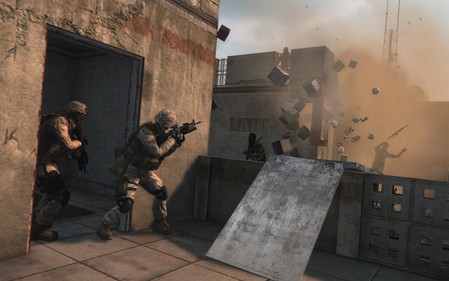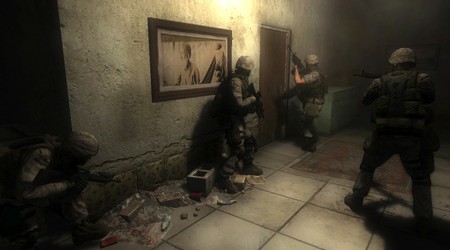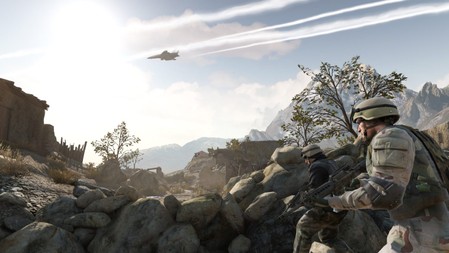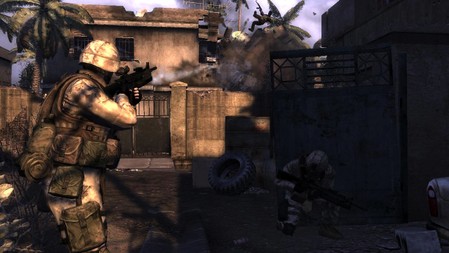‘Six Days in Fallujah’: A Bloody Iraq Battle and Video Game That Almost Was
By Matt Paprocki
LOS ANGELES (Variety.com) – Before “Call of Duty” turned from a World War II series and into a modern military blockbuster, game developer Destineer, with studios in both Raleigh and Minneapolis, began crafting “Six Days in Fallujah.” Its dramatic interactive take on a deadly, real-life Iraq battle, mixed in interview footage from marines who were there, to accurately depict a recent wartime event.
“
The greatest generation has Normandy. Gen X will have Fallujah,” writes SSG David Bellavia in his book “House to House,” recounting his November 2004 experience within the Iraqi city. The Department of Defense called “some of the heaviest urban combat Marines have been involved in since Hue City in Vietnam in 1968.”
Yet, Fallujah’s story never reached beyond text and documentaries. Unlike “Black Hawk Down” or the recent “12 Strong,” Fallujah’s story remains cinematically untold.
But it almost happened. Soon after the military’s operation, after two months of combat, Destineer (and a secondary brand, Atomic Games) headed by founder Peter Tamte, took up the mantle to make a video game based on the Fallujah battle, with a focus on precisely detailing what happened. Destineer spent between three and four years on “Six Days in Fallujah.”
Yet, the Fallujah saga remains untold in interactive form because of political concerns, marketing fumbles, press pressure, and expensive development. Not all was wasted though. In time, “Six Days in Fallujah” could still happen.
The Fallujah Fight
The second assault on Fallujah (after the Iraq government canceled the first in April 2004), began in November of 2004 and is where “Six Days in Fallujah” stemmed from. While the mission was a tactical success, 107 coalition soldiers died in combat. It’s estimated that 1,200 to 2,000 insurgents were killed.
By design, civilians in Fallujah were warned in advance. U.S. troops fought on the north end of Fallujah as a diversion, with plans to move in from the south to gain tactical advantage.
“The fight we initially dealt with in the northern end of the city was a lot less intense. We were able to penetrate into the city quickly. The more challenging fighters were able to reposition themselves closer to where we were,” infantry officer Read Omohundro told
Variety
.
Along with a high casualty count, the battle included a number of awful circumstances. Bellavia’s book described one soldier who endured a deadbolt lock stuck in his scrotum after an RPG blew open a gate. Soldiers dealt with illness including long bouts of diarrhea and limited means of cleansing in high desert heat. In the end, Omohundro believed the fight to be a success. The media response, however, left much to be desired in his view.
“Al Jazeera did a pretty significant job giving the impression we were in there killing a bunch of civilians because most of the fighters were not wearing a uniform,” says Omohundro. “Anytime you do that, it’s real easy for a media company or anybody to go in and say, oh, you’re killing all these civilians. When they’re in mortuary affairs, they’re lined up for the families to come in and identify, they’re not sitting there with firearms next to them. They’re not seeing what we were seeing on the actual battlefield.”
The origins of Destineer’s involvement came from men who served. “The idea started with a Marine sergeant who had been medevaced out of Fallujah during the battle. I knew him well because he was one of the Marines who had been sent to our offices to help us build training systems. He called me just a few weeks after the battle and told me stories from Fallujah that were just incredible. … Then, he asked me whether we could build a game to recreate these stories,” Destineer and Atomic Games founder Peter Tamte told Variety.
“The main thing I want to get across is the importance of the stories of the marines that we worked with and we were inspired by,” begins Creative Director Juan Bonito to
Variety
. “That was the whole point of the game was to make people understand what those individuals faced. The horrors! That was another pillar – horrors in heroism, contrasting some really horrible stuff. I saw the videos. … We wanted to push the limits of what we could show in a game to do that, and players could have empathy and understand the people who really experienced it.”
“The stuff they did in Fallujah was old school, old time combat and people don’t even know that,” says Engine Developer Cowgill.
At Destineer
At the start of 2005, Destineer was developing training simulators for the CIA and FBI titled “Judgmental Shooting Simulator,” concurrently developing narrative-driven games using those simulators as a basis for mass market appeal. The studio wanted to translate Fallujah’s grueling combat in the same way.
With the primary platform being PC, an Xbox 360 port and later PlayStation 3 edition were planned. “Six Days in Fallujah” would carry the Atomic Games brand, not Destineer. “Peter [Tamte] was telling the team, ‘Look, this is a very powerful brand and web address because it was really desired. We’re going to bring this brand back to life and we’re going to use this brand for a big AAA commercial game,’” says Nathan Cheever, lead campaign designer.
Self-funded development began in early 2006.
“What we had set on was the first war documentary that was a video game. We could set up this is what really happened, we could then recreate it to a certain extent and put you in that position so that you had empathy for those who were in that position. You can also experience to a limited degree, through the media of a game, what they experienced and the decisions they had to make,” says Bonito.
Initial design opened to a square mile of city space, around four to five blocks. Faced with combat uncertainty, players would need to make snap decisions as to how, where, and when to attack as the urban scenario made it difficult to separate enemy from civilian. Key to this endeavor was destruction.
“There were options that the marines themselves faced and utilized because they have this concept called shape the battlefield where they don’t really care about walls. They want to get the best tactical position so walls come down all the time. We wanted to give the player the opportunity too,” says Bonito.
“The engine could destroy everything. It was beautiful. Everything could fall apart almost down to the brick,” says Cowgill.
Beautiful or not, this didn’t always represent the reality. Omohundro remembers meeting one of the programmers who was showing the damage done by grenades. “The destruction was pretty devastating. I was telling him, that’s pretty cool, but you know, an actual grenade doesn’t cause that much damage and destruction in those types of buildings over there. We were going back and forth on this and his key argument was, I’ve been designing video games forever and this is what grenades do in these video games,” Omohundro says laughing.
Destruction, however, is difficult to display in video games. This involves physics, graphical changes, processor horsepower, and other complications. While “Six Days in Fallujah” did progress, many of the issues faced by the team stemmed from this destruction, leading to a development that lasted years with slow progress.
“Nobody had done destruction to this extent and still hasn’t. … Unfortunately, this decision inadvertently caused us to spend the first three years building an engine instead of a game. Building the technology or a fully destructible game world created all sorts of complications that are hard to see until you’re very far into development. Everything falls out from this one decision to create a fully destructible game world, and I’m the one who pushed for it and authorized it, so it’s my fault,” writes Tamte.
Bending Political Reality
Consider the location: Alongside destruction, cultural concerns enter the discussion, particularly religious sensitivities. “Even though it was a fully destructible game, we’re not going to allow anyone playing the game to destroy mosques. We don’t want that to be recorded, videoed, and then put on YouTube and it shows people laughing. Suddenly, you’d trivialized a nation’s culture,” says Cheever.
“Everything around [the mosque] can be destroyed except that. Then it looked like we were almost making a religious statement. The power of that structure and that religion,” says Bonito. We had a cutscene that was based on a real video clip that we had where Marines had destroyed a mosque and a tower was falling. Very dramatic footage. We recreated it with motion capture and animation. That had to be cut because it was seen as too religiously sensitive,” referring to a decision made by unspecified higher-ups at Destineer/Atomic.
Another level involved a firefight inside a cemetery. Although finished, that level was cut because of potential insensitivity toward grave sites. Other changes became necessary for the format.
“In the real world, you might have 200 meters of flat ground to get to the next building. In a game, that’s a lot of nothing. We shrunk things and shaped things a little bit, but they’re all based on the original locations and condensed into a game,” says Cheever.
Accuracy was tantamount to the team. Bonito stated he collected over 80 hours of interviews with Marines who fought in Fallujah. Omohundro came on as a consultant. “I started talking with the software engineers and the other programmers that were making sure some of the city aspects as well as the architecture as well at movements and behavior characteristics for the weapon systems, as well as some of the marines behavior characteristics, were in line with reality of the events,” says Omohundro.
Cowgill explained a basic scenario set-up in “Six Days in Fallujah.”
“The example we used quite a bit was you’re a squad leader and you’re clearing the left side of the street down Fallujah. You see civilians on the other side of the street in their house as you clear houses. Later, you start taking fire from that house. You have three options. You can turn around and clear that house, kick down the doors and do what you need to. Maybe get some marines injured, maybe injure some civilians, but you’re taking fire from the house. The second option is to leave it for the next squad behind you to clear so that they take the risk. The third option is to call in an airstrike. Of those three bad options, which do you choose?” says Cowgill.
Moving Day
With technical burdens building, a decision was made to bring “Six Days in Fallujah” entirely to Destineer’s Raleigh, North Carolina location. Cheever remembers four or five levels in an alpha state after a year or more of development, and once the Raleigh team was set, “Six Days in Fallujah” underwent a reboot.
Gone was the open approach and levels condensed into tighter designs, both for the sake of destruction and scheduling.
“At the end, because the events happened on different phase lines that happened north to south, we decided to have two different fireteams [of four marines],” remembers Cheever.
In addition to a shift in focus, Cheever recalls a “death by demo” process, where the team is pulled off the main game to develop demos or proof of concepts for trade shows or potential publishers. “That halts development of the complete game because people keep getting sucked into expressing things that will not be done in the full game,”he says.
“The view at the time was always to put the best foot forward. …. that drains away resources from the main development. We’d often find ourselves creating an important demo for a specific aspect of the project, but it created quite a drain on the team,” says Bonito.
Tamte disputed this schedule, however. “The game was self-funded for the first few years and then found funding very quickly the first time we needed it, so there were only 3-4 times during 4 plus years of development that we built a one-off so we could market the game to someone.”
Those someones varied over the years. Destineer/Atomic Games sought a variety of publishers, from industry giants like (who potentially viewed “Fallujah” as an extension of its “Medal of Honor” series) or Bethesda. Atomic even approached console makers Microsoft and Sony. None of their pitches were successful. “The biggest challenge was that most of the ones that could afford to publish ‘Six Days’ already had their own military shooter franchises either in development or on the market,” says Tamte.
EA, for instance, did reboot its “Medal of Honor” series but did so on their accord in 2010. Others were concerned by the content and how this could impact their market share outside of the U.S.
“Some of these publishers were headquartered in Europe or Asia that have completely different geopolitical frames of reference on the Iraq war,” says Bonitio.
One publisher did take on “Six Days in Fallujah.” That was Japan-based studio Konami who signed on in 2008. For a year, supported “Six Days in Fallujah’s” development, if not in the way the developers hoped. Announced at Konami’s Gamer’s Night in 2009, “Six Days in Fallujah” featured alongside the likes of horror games “Silent Hill” and “Saw: The Video Game.” Konami brought out a Fallujah veteran to speak, then pushed out a sizzle reel of real-world Iraq war footage combined with run-and-gun gameplay footage, muddying the message.
Speaking to the Wall Street Journal , Konami’s Anthony Crouts failed to mention the documentary style, stating, “We’re not trying to make social commentary. We’re not pro-war. We’re not trying to make people feel uncomfortable. We just want to bring a compelling entertainment experience.”
That worked for Konami, until executives began to fear political backlash.
Survivors, the Dead, and Fox News
Basing “Six Days in Fallujah” in reality brings up a number of difficult questions. In a hunt for accuracy, a debate began internally regarding the depiction of actual soldiers. The answer was not to include real named soldiers as playable characters, although this didn’t end the debate.
“Would there be support characters that were real characters in the game? And if they are there, how do you deal with them being killed or is it just a game situation where they don’t die? Or, everyone is made up and it’s just the interviews that express the idea with the real people,” explains Cheever.
“We eventually arrived at a place where we had all of the reality in the book-ended video documentary pieces and we had it in the reality of a tactical situation, but the marines themselves were somewhat abstracted. … We worked with over a dozen marines during the entire phase of development. They inspired marine characters in the game. We didn’t show any real individual or simulating them losing their life. That would have been beyond the pale,” says Bonito.
For full accuracy, Destineer’s team asked an American Iraq-based journalist to interview people in Fallujah, to hear their side, even some insurgents.
“I probably had sixty hours of marine interviews and another 20-25 hours from Iraq itself. … the real problem was we were going for a real documentary which meant more than one viewpoint in trying to get the whole story, being real journalists,” explains Cowgill.
That job, of an Iraqi reporter, was not an easy one and put some people in real danger. “Iraqis in Fallujah assumed he was CIA. He couldn’t go back into the city after helping us because they thought he was a spy. He had hired a couple of Iraqi journalists to get the stories and talk to people but it became dangerous for all of them after that because of that environment,” explains Cowgill.
Between a failure of pre-release marketing to tell the public about the documentary approach and the idea of insurgents being involved, “Six Days in Fallujah” came under fire. In a Fox News interview, Tamte, Omohundro, and the mother of a fallen soldier, Tracy Miller, were featured in a segment. Miller decries the game because it could feature her son, a difficult situation made worse by how the interview was conducted.
“I was sitting in like a broom closet type of environment, staring at a camera, with an earpiece, and I was unable to physically see any of the interactions of the other people during the interview. It was difficult for me to not see the body language or some of the concepts that were being talked about,” remembers Omohundro.
The general public’s perception of a video game, along with the content of “Six Days in Fallujah,” made marketing problematic.
“Everybody had some form of ‘Call of Duty’ in their head of just a run and gun shooter, nothing but fun. The storytelling and documentary aspects were completely lost in the messaging,” says Cowgill.
“It felt like a siege. We knew what was happening in the studio. We knew the validity of the content we were making, and the vision around it. I was convinced and I think the team was as well. We weren’t able to articulate that to the outside world in the way we wanted to. It all felt like a big, unjust misunderstanding,” says Bonito.
Rejection
Development continued until late April 2009, the same month as the Gamer’s Day demo. On a day when Bonito completed negotiations with Evan Wright, writer on the HBO series “Generation Kill,” to pen the story, the phone rang. “I had just started lunch, then I got the call that Konami was pulling the plug. Then I had to go back in and finish lunch.”
“I got a phone call from the EVP at Konami who oversaw our project to explain that Konami of Japan was going to announce it was pulling out and that it would be in the next day’s Tokyo newspapers,” writes Tamte.
Fear over “Six Days in Fallujah’s” real world content and media coverage scared Konami higher-ups. “Basically, once Konami Japan realized they had a controversial game on their hands, everything just went quiet from Konami. The support just dropped,” says Cowgill.
Note: When asked, Konami PR stated they had no one who could speak about “Six Days in Fallujah.”
This did require Konami to renege on their contract, using a ‘termination for convenience’ provision. “This allowed them to pay us a fee to terminate the agreement, in which case 100% of the rights to the project would revert back to us,” explains Tamte.
Back into the publishing waters Destineer went, funded by the termination agreement, and on another hunt for a potential publisher. However, by this time, “Call of Duty: Modern Warfare” turned into a blockbuster, and publishers had their own counterparts already in development. Destineer even sought a studio in Russia. “Fallujah” didn’t fit their schedules, and Destineer was denied.
“After it became clear that none of the big publishers could do ‘Six Days,’ we wound down the team to just a core group and created a new game called ‘Breach’ with our game engine,” writes Tamte.
“‘Breach’ was essentially the multiplayer child of ‘Six Days’ in the effort to save something,” says Cowgill.
“Breach” debuted on the Xbox 360’s digital Xbox Live Arcade service in January 2011, breaking even financially, not enough to sustain the studio. Destineer shuttered in May 2011.
“When the layoffs happened, there were people shocked for sure because they’d never been laid off before. A girl was crying on the phone to her dad in one of the side offices. … I was already content with the outcome because I knew it was going to happen. The downside was two days later I was going to fly off to my wedding and it was like, you’re in this new chapter of your life and one drastically cuts one open,” says Cheever.
Life in Death
With the advancement of technology and distance from the Iraq war, something like “Six Days in Fallujah” might carry market value today.
“I think now enough time has passed and people have seen the diversity particularly with virtual reality games and how that technology is so different. I’m hoping one day we’ll be able to get to a point where this documentary type video game, or this reenactment through gaming technology, will allow people to experience something that wasn’t physically possible 10 years ago,” says Omohundro.
“You would have learned something. That was the biggest thing I was excited about. If people played through it, they would have realized wow, military, war is not something to be completely trivialized,” says Cheever
To Tamte, not all is lost. Atomic Games is still a brand and he holds all of the necessary pieces.
“I archived all of the assets for ‘Six Days in Fallujah,’ including the interviews we conducted with Marines just weeks after the battle, terabytes of video, photos, and documents from the battle, as well as all the game code and art assets,” writes Tamte.
“Someday,” he said, “we are going to finish what we started.”




